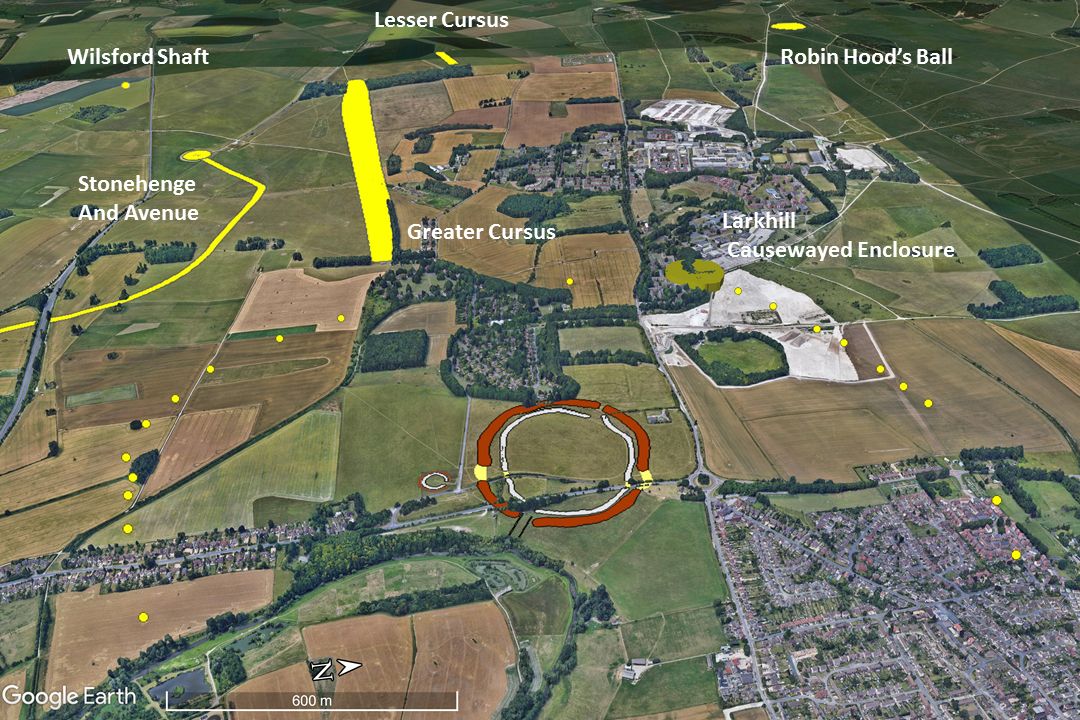Update: This article was updated at 3.30pm on 23 June to include a quote from Prof Vince Gaffney and to indicate the involvement of his department at the University of Bradford.
A team of archaeologists have discovered a major new prehistoric monument just a short distance away from Stonehenge.
Fieldwork and analysis have revealed evidence of 20 or more massive prehistoric shafts – more than 10 metres in diameter and five metres deep – forming a circle more than two kilometres in diameter around the Durrington Walls henge.
Coring of the shafts suggest the features are Neolithic and excavated more than 4,500 years ago – around the time Durrington Walls was built.
It is thought the shafts served as a boundary to a sacred area or precinct associated with the henge.
Experts from the University of St Andrews were joined by counterparts from institutes including Birmingham, Warwick, the University of Wales Trinity Saint David and the Scottish Universities Environmental Research Centre (at the University of Glasgow). The discovery was made as part of the Stonehenge Hidden Landscapes Project, led by the University of Bradford.
Prof Vince Gaffney, 50th Anniversary Chair of the School of Archaeological and Forensic Sciences in the Faculty of Life Sciences at the University of Bradford, said it was extraordinary such a major find had been made so close to Stonehenge:
The area around Stonehenge is amongst the most studied archaeological landscapes on earth and it is remarkable that the application of new technology can still lead to the discovery of such a massive prehistoric structure which, currently, is significantly larger than any comparative prehistoric monument that we know of in Britain, at least.
When these pits were first noted it was thought they might be natural features – solution hollows in the chalk. Only when the larger picture emerged, through the geophysical surveys undertaken as part of the Stonehenge Hidden Landscape Project, could we join the dots and see there was a pattern on a massive scale.
Dr Richard Bates, of the University of St Andrews’s School of Earth and Environmental Sciences, said: “Yet again, the use of a multidisciplinary effort with remote sensing and careful sampling is giving us an insight to the past that shows an even more complex society than we could ever imagine.
“Clearly sophisticated practices demonstrate that the people were so in tune with natural events to an extent that we can barely conceive in the modern world we live in today.”
Tim Kinnaird, of the same school, said: “The sedimentary infills contain a rich and fascinating archive of previously unknown environmental information.
“With optically stimulated luminescence profiling and dating, we can write detailed narratives of the Stonehenge landscape for the last 4,000 years.”

The announcement of the discovery comes after the Summer Solstice, which took place online this year with the annual gathering cancelled due to coronavirus.
English Heritage has provided access to the event since 2000 but warned visitors not to travel to the 3,000BC Neolithic monument this year.
Dr Nick Snashall, National Trust archaeologist for the Stonehenge and Avebury World Heritage Site, hailed the “astonishing discovery”.
He said: “As the place where the builders of Stonehenge lived and feasted, Durrington Walls is key to unlocking the story of the wider Stonehenge landscape, and this astonishing discovery offers us new insights into the lives and beliefs of our Neolithic ancestors.
“The Hidden Landscapes team have combined cutting-edge, archaeological fieldwork with good old-fashioned detective work to reveal this extraordinary discovery and write a whole new chapter in the story of the Stonehenge landscape.”











